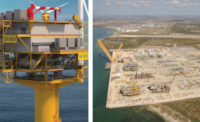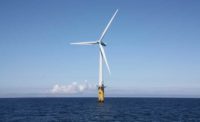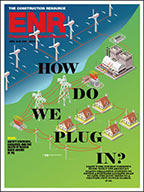
The 30-MW Deepwater Wind offshore wind farm—for which the first of five 400-ton turbine jacket foundations was installed three miles off the coast of Rhode Island on July 27—has now progressed beyond similar ventures in Northeast U.S. waters that remain mired in court battles or regulatory red tape.
A joint venture of contractors Weeks Marine and Manson Construction completed the first installation for the five-turbine demonstration project that is set to generate power by late next year.
Abigail Ross Hopper, director of the U.S. Interior Dept.'s Bureau of Ocean Energy Management, termed the $290-million Block Island pilot project “our nation’s first offshore wind farm” and “a major step forward in a sustainable offshore wind program for the Atlantic Coast.”
While Deepwater Wind hosted VIPs aboard Weeks Marine’s custom-made installation vessel, neither the developer’s officials nor contractors responded to interview requests and a spokeswoman declined to provide construction details. The vessel has a 280-ft boom and can carry three wind turbines at one time, according to the contractors’ website.
Executives say Deepwater Wind is fully financed. “The project is expected to reduce [electricity] costs for Block Islanders
by 40%,” says a project spokeswoman.
The Block Island project, one of three offshore wind projects off the Rhode Island coast between Martha’s Vineyard and Block Island, won development rights for a wind farm of up to 200 turbines. The other two—12 miles south of Martha’s Vineyard and Nantucket—include Denmark-based Dong Energy and Offshore MW, the U.S. arm of a German company.
The five steel jacket foundations were fabricated at Gulf Island Fabrication Inc., Houma, La., beginning in late 2014, then shipped to Rhode Island by barge. Fabrication work on components of the foundation substructures was done at the Quonset Point facility of Specialty Diving Services.
During the roughly eight-week construction period this summer, more than a dozen construction and transport barges, tugboats, crew ships and monitoring vessels will be active at the offshore construction site, according to a Deepwater Wind statement.
Submarine cable installation for the wind farm is set to begin next spring, and erection of the five Alstom Haliade 6-MW offshore wind turbines is set for next summer.
The project follows the planned 127-turbine Cape Wind project off the Massachusetts coast, which has been mired in legal battles for more than a decade. Earlier this yearm utility companies National Grid and NStar said they were withdrawing from their commitments to buy power from the Cape Wind project.
The five-turbine Fishermen’s Energy wind farm in offshore New Jersey also has been hampered by state regulators' rejections becuase of power cost issues for state ratepayers.




